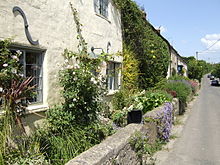Batcombe, Somerset
| Batcombe | |
|---|---|
Avon and Somerset | |
| Fire | Devon and Somerset |
| Ambulance | South Western |
Batcombe is a village and
History
The name Batcombe comes from Saxon and means "Bat's Valley".[2]
Around 2 miles (3 km) from Batcombe village is an
Batcombe is thought to have been established around 660
The Mendip district was, for several centuries, highly dependent on the wool industry, with which these villages were linked.
Westcombe was for many years property of
For a long time the Bisse family owned much property in Batcombe, as well as other local villages, including Spargrove.
The Church of St Mary the Virgin dates from the 15th and 16th centuries and was restored in the 19th. The tower contains five bells dating from 1760 and made by Thomas Bilbie, of the Bilbie family, in Cullompton.[4] It has been designated by English Heritage as a Grade I listed building.[5]
In the 1643 the people of Batcombe got into a fight with the people of Bruton.[6]
Batcombe has a war memorial dedicated to those who gave their lives in World War I. The war memorial in Westcombe has engraved on it around 12 names. It was originally a family memorial to Henry Ernst in 1913, but it was later converted to a war memorial in 1919.
In 1933 Batcombe village hall was built next to the village school. The hall was constructed largely of timber and built by local villagers. By the 1990s the hall's age was beginning to show, and it was clearly
The property in Westcombe was historically owned by a single family, the Ernst family who lived in the Georgian country house of Westcombe House. Most of the estate was sold in 1927, and divided between two daughters. One inherited Westcombe House and the other all the family's wealth. The house fell into disrepair, and was demolished in the early 1950s. Today the hamlet is home to a small industrial site owned mainly by Milton-Westcombe Farms Limited. The largest business operation on site is that of the Bay Tree Food Company, which produces handmade pickled and jam goods sold across the UK.
Governance

The
The village falls within the
It is also part of the
Before
Notable people
- Henry Albin (1624–1696) – minister.
 This article incorporates text from a publication now in the public domain: "Albin, Henry". Dictionary of National Biography. London: Smith, Elder & Co. 1885–1900.
This article incorporates text from a publication now in the public domain: "Albin, Henry". Dictionary of National Biography. London: Smith, Elder & Co. 1885–1900. - Richard Alleine (1610–1681) – Puritan minister.[8]
- Richard Bernard (1568–1641) – Puritan minister.[9]
- Philip Bisse (1540–1613) – Puritan Minister, Archdeacon of Taunton, gave nearly 3000 books to found the library at Wadham College, Oxford.[10]
References
- ^ a b "Batcombe Parish". Neighbourhood Statistics. Office for National Statistics. Retrieved 1 January 2014.
- ISBN 1-902007-01-8.
- ^ "Somerset Hundreds". GENUKI. Retrieved 22 October 2011.
- ISBN 0-9526702-0-8.
- ^ Historic England. "Church of St. Mary the Virgin (1234822)". National Heritage List for England. Retrieved 5 October 2007.
- ^ "Bruton British History Online". www.british-history.ac.uk. Retrieved 5 March 2017.
- ^ "Shepton Mallet RD". A vision of Britain Through Time. University of Portsmouth. Retrieved 4 January 2014.
- ^ Stephen Wright, 'Alleine, Richard (1610/11–1681)', Oxford Dictionary of National Biography, Oxford University Press, 2004, accessed 17 September 2008
- ^ "Bernard, Richard (BNRT592R)". A Cambridge Alumni Database. University of Cambridge.
- ^ "Upton Noble". A History of the County of Somerset: Volume 7: Bruton, Horethorne and Norton Ferris Hundreds (1999), pp. 59–63. British History Online. Retrieved 21 November 2010.

